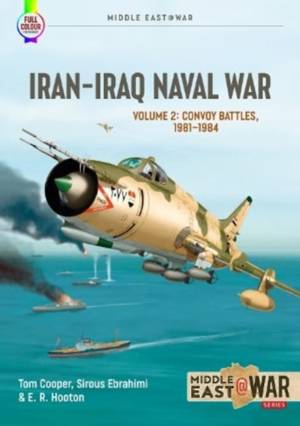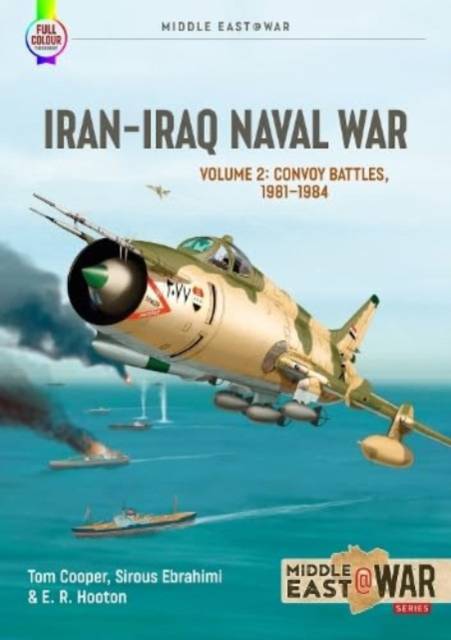
- Retrait gratuit dans votre magasin Club
- 7.000.000 titres dans notre catalogue
- Payer en toute sécurité
- Toujours un magasin près de chez vous
- Retrait gratuit dans votre magasin Club
- 7.000.0000 titres dans notre catalogue
- Payer en toute sécurité
- Toujours un magasin près de chez vous
Iran-Iraq Naval War
Volume 2 - Convoy Battles, 1981-1984
Tom Cooper, E R Hooton, Farzin Nadimi, Milos Sipos
27,95 €
+ 55 points
Format
Description
"... a significant contribution to this forgotten part of the Iran-Iraq War, the naval aspect of which only heretofore came to the attention of Westerners when their warships started to enter the Persian Gulf in large numbers in 1987. The quality of the writing is quite good, although understandably very detailed." -National Maritime Historical Society
Well away from the major battlefields on the ground in the Iran-Iraq War, and hidden from the gaze of the curious public, the navies and air forces of the two belligerents contested the waters of the Persian (or Arabian) Gulf. This naval aspect of the war still remains largely unknown and hugely underreported in the West other than in terms of the 'Tanker War' and the impact upon international shipping.
Yet this was a war in which Iran and Iraq pitted the best technologies available to them - bought from the world's leading arms manufacturers and exporters - against each other's vital oil production and exports, and against vital maritime lifelines. Iran in particular relied upon 'caravans' of shipping to import raw materials, provide logistic support to the land war, and to export oil-based products. Iraq would make the first (and by far most extensive) combat use of the famous Exocet anti-ship missile long before its first claimed use by Argentina in the Falklands/Malvinas War and would make extensive use of French-sourced electronic warfare capabilities and Soviet anti-radiation missiles. Iran would make the first combat use of the F-14 Tomcat and its associated AIM-54 Phoenix air-to-air missile and would be the first to launch the RGM-84 Harpoon surface-to-surface missile in anger. Far from being a backwater, this was the testing ground for many cutting-edge technologies.
Volume 2 of Iran-Iraq Naval War draws upon unique access to Iranian naval archives and examines in detail the naval war between 1981 and early 1984 as Iraq struggled to defeat Iran's highly organized maritime 'caravans, ' how each side experienced successes and failures in the employment of new technologies, and their efforts to counter these. This book is illustrated throughout with original photographs, many in color and never previously published in the West, and with specially commissioned color maps and the @War series' signature color artworks showing the ships and aircraft employed in this war.
Well away from the major battlefields on the ground in the Iran-Iraq War, and hidden from the gaze of the curious public, the navies and air forces of the two belligerents contested the waters of the Persian (or Arabian) Gulf. This naval aspect of the war still remains largely unknown and hugely underreported in the West other than in terms of the 'Tanker War' and the impact upon international shipping.
Yet this was a war in which Iran and Iraq pitted the best technologies available to them - bought from the world's leading arms manufacturers and exporters - against each other's vital oil production and exports, and against vital maritime lifelines. Iran in particular relied upon 'caravans' of shipping to import raw materials, provide logistic support to the land war, and to export oil-based products. Iraq would make the first (and by far most extensive) combat use of the famous Exocet anti-ship missile long before its first claimed use by Argentina in the Falklands/Malvinas War and would make extensive use of French-sourced electronic warfare capabilities and Soviet anti-radiation missiles. Iran would make the first combat use of the F-14 Tomcat and its associated AIM-54 Phoenix air-to-air missile and would be the first to launch the RGM-84 Harpoon surface-to-surface missile in anger. Far from being a backwater, this was the testing ground for many cutting-edge technologies.
Volume 2 of Iran-Iraq Naval War draws upon unique access to Iranian naval archives and examines in detail the naval war between 1981 and early 1984 as Iraq struggled to defeat Iran's highly organized maritime 'caravans, ' how each side experienced successes and failures in the employment of new technologies, and their efforts to counter these. This book is illustrated throughout with original photographs, many in color and never previously published in the West, and with specially commissioned color maps and the @War series' signature color artworks showing the ships and aircraft employed in this war.
Spécifications
Parties prenantes
- Auteur(s) :
- Editeur:
Contenu
- Nombre de pages :
- 80
- Langue:
- Anglais
- Collection :
Caractéristiques
- EAN:
- 9781915070807
- Date de parution :
- 04-07-24
- Format:
- Livre broché
- Format numérique:
- Trade paperback (VS)
- Dimensions :
- 206 mm x 292 mm
- Poids :
- 299 g

Les avis
Nous publions uniquement les avis qui respectent les conditions requises. Consultez nos conditions pour les avis.






